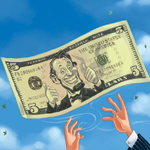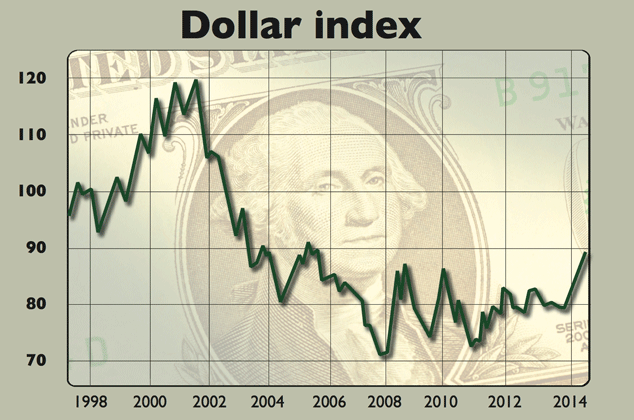The dollar makes its move – and the only way is up
About once a decade, the dollar makes a world-shaking lurch. It’s time to prepare for the next one, says James Ferguson.

About once a decade, the dollar makes a world-shaking lurch. It's time to prepare for the next one, says James Ferguson.
In March 2012 I wrote a piece in MoneyWeek warning that the big financial story of the next five years would be the relentless rise of the US dollar. The dollar had been gettingslowly stronger since summer 2011.
But this year, the trend has accelerated. The dollar is up by 8.5% since July alone (measured against a basket of its biggest rival currencies see the chart), and last week's news that the US had added tens of thousands more jobs than expected in November merely added fuel to the fire.
MoneyWeek
Subscribe to MoneyWeek today and get your first six magazine issues absolutely FREE

Sign up to Money Morning
Don't miss the latest investment and personal finances news, market analysis, plus money-saving tips with our free twice-daily newsletter
Don't miss the latest investment and personal finances news, market analysis, plus money-saving tips with our free twice-daily newsletter
What's driving this? The most important factor by far is monetary policy. Between 2002 and early 2008, the dollar lost more than a third of its value. That was down to former Federal Reserve chairman Alan Greenspan's low interest-rate strategy, and the credit bubble it created. Then the financial crisis hit.
Investors panicked and rushed to safe havens including the dollar. The currency's value jumped by almost 20%. But it gave all that back in the years that followed despite the turmoil in Europe mainly due to quantitative easing (QE).
We all know QE is a powerful monetary tool it's one of the main reasons why both the S&P 500 and the US economy are back above their pre-crisis peaks. But what gets far less attention isthe quid pro quo currency weakness.
US QE has pumped trillions of dollars into the economy. Some of those dollars have gone into stocks or property, while some have boosted demand for goods and services. But basic economics tells us that when you raise the supply of something, you hit the price money is no different.
Yet rather than see this as the US dollar falling, investors tend to see it as the price of all things denominated in dollars rising: the S&P 500, gold, rival currencies, commodities, and emerging-market bonds, to pick a few.
The list is long, and looks a lot like a global bull market (helped by the fact that many of the assets aren't that liquid, so a little demand goes a long way). But much is just US dollar weakness.
So the dollar has been diluted. As a result, its price over the last decade has fallen as billions, even trillions, of greenbacks have flowed offshore. With two-thirds of all global business transacted in dollars, this has greased the wheels of world trade, and funded the extraordinary infrastructure growth of China and the rest of the emerging world.

The dollar's dark side
However, there's a dark side to the boom. People become seduced by cheap credit when the dollar is weakening. In effect, a weak dollar is like a massive interest-rate cut for the rest of the world.
The Bank for International Settlements reckons that cross-border credit (mostly denominated in dollars) now totals $10trn. That's three times the size of the entire US QE programme.
For example, dollar loans to China now amount to $1.1trn (+47% year-on-year), having grown from almost nothing just five years ago. The trouble is, when the dollar turns, it gets more expensive for all these dollar borrowers to pay their debts it's like tightening monetary policy for the entire globe.And that's what's happening right now.
Here's how it works. The emerging-market economic cycle a cycle that last ended so spectacularly two decades ago, with the Asian crisis in the 1990s tends to build up when dollar credit is cheap.
This time round, at first, emerging economies had trade surpluses (they exported more than they imported) and a wealth of necessary, productive infrastructure projects to invest in.
But once the credit lines opened up, funding flowed so efficiently that many emerging markets now run deficits cheap credit enables them to import more than they export. As happens when credit is easy, borrowers became complacent. Seeing the weak US dollar, accompanied by chronically low interest rates, they borrowed in dollars.
Meanwhile, the projects they invested in became ever more speculative. China, for example, tells the world that its economy is growing by 7%-8%. But we know that China underestimates its inflation (which means it overestimates how much of this growth is real). We just don't know by how much.
What we do know is that productivity growth in China has fallen from 8% in 2008 and turned slightly negative last year. More and more debt is funding less and less efficient infrastructure. I recently returned from Shanghai, where it is commonly believed that two-thirds of all new residential buildings remain empty. Presumably it's even worse out in the regions.
The next great rally
None of this is necessarily a problem if the rising dollar is a fleeting reflectionof volatility. But neither history nor the monetary fundamentals suggest this is so. About once a decade the US dollar has a big move a properly world-shaking revaluation.
In the 1970s oil crisis, the dollar rose 50% against sterling. It rose by a similar amount against a trade-weighted basket of currencies in the early 1980s oil shock too. And in the latter half of the 1990s, the dollar rose by 40%.
The onset of the financial crisis in 2008 saw it swiftly gain 20%, but this was forestalled by QE. That's also been the main reason why, at least until now, the euro has remained relatively firm.
So, the dollar is long overdue another big move up, moves that historically coexist with words like 'crisis' or 'shock'. And we can already see the fundamental underpinnings of the next great dollar rally. QE has ended. Over $3trn of dilutive money printing since 2009 is finally over. US banks are lending again, so the money supply is growing of its own accord (in other words, the US doesn't need QE any more).
And the US economy again leads the world. North America is the only economic bloc in the G10 where the economic data are consistently surprising to the upside. Even though QE3 has been gradually phased out over the past year, America's GDP grew at anannualised rate of 4% in the third quarter.
In short, the US has ended QE while maintaining its economic momentum. It's also running less of a deficit due to booming shale oil and gas production. At the same time, Europe is slowing to a halt, Japan is embarking on currency-dilutive QE, and even China seems to have hit the wall it may even be lining up more 'stimulus'.
In the currency stakes, this looks like a one-horse race. The dollar's role as global reserve currency means this matters it will mean more demand for a shrinking supply of dollars. That's bad news for global money supply growth.
The 8.5% surge in the dollar's strength since July has seen the global money supply (in dollar terms) shrink by 5.7%. Before this, the rest of the world was seeing annual money supply growth of 5.5%. Even after adjusting for dollar strength, world money supply growth is now near zero.
Dollar strength has its benefits. Oil prices have fallen by a third since the dollar took off. Countries that export to the US, like Japan, Germany, and China, will enjoy higher prices for their products once their currency hedges expire.
Many FTSE 100 stocks report earnings in US dollars, which will translate back into sterling at a higher rate.
But the main beneficiaries will be cash held in US dollars, and near-cash investments, such as US Treasuries even though the US has the strongest growth outlook in the world (which should drive its government bond yields higher and prices down) the US ten-year Treasury already yields just 2.3%, and the 30-year less than 3%, as those with dollar-denominated debts scramble to hedge their exposure. We look at the best ways to profit and what to avoid in the box on the left.
James Ferguson is a founding partner of the MacroStrategy Partnership LLP (www.macrostrategy.co.uk).
What to buy now

You might be tempted to buy US stocks as a way to play the dollar, but that's not the way to go, writes John Stepek.
As James points out above, QE has helped boost US stocks to levels that are now arguably very overpriced. With QE ending, and the dollar strengthening, US stocks will struggle to justify their valuations. A better bet is to buy big British stocks that earn a lot of money in dollars.
That doesn't mean you can blithely buy the whole FTSE 100 index a lot of the dollar earners are oil stocks and miners, and the tough times for those could continue for a while before things get better certainly they've had a hard time since we last wrote about the strengthening dollar in October.
But good examples of dollar earners that look decent value too include pharma giant GlaxoSmithKline (LSE: GSK), which trades on a dividend yield of more than 5% andgets a third of its revenues from the US.
You could consider AstraZeneca (LSE: AZN) on a near-4% yield, although it's already done very well this year due to bid speculation. Defence company BAE Systems (LSE: BA) generates around 40% of its sales in the US, and yields 4.8%. Drinks giant Diageo (LSE: DGE) offers a 3% yield and earns a third of its revenues in America.
We'd be wary of investing in government debt. You certainly shouldn't touch emerging-market debt financial historian and analyst Russell Napier recently highlighted it in an interview with MoneyWeek as one of the most dangerous asset classes around just now.
But as James points out, US Treasuries could well benefit from any rush to safe havens, and they also offer exposure to the rising US dollar. The iShares $ Treasury Bond 7-10yr exchange-traded fund (LSE: IDTM) is one simple way to play US government bonds.
Get the latest financial news, insights and expert analysis from our award-winning MoneyWeek team, to help you understand what really matters when it comes to your finances.
James Ferguson qualified with an MA (Hons) in economics from Edinburgh University in 1985. For the last 21 years he has had a high-powered career in institutional stock broking, specialising in equities, working for Nomura, Robert Fleming, SBC Warburg, Dresdner Kleinwort Wasserstein and Mitsubishi Securities.
-
 Why Trustpilot is a stock to watch for e-commerce exposure
Why Trustpilot is a stock to watch for e-commerce exposureTrustpilot has built a defensible position in one of the most critical areas of the internet: the infrastructure of trust, says Jamie Ward
-
 Tetragon Financial: An investment trust with stellar returns
Tetragon Financial: An investment trust with stellar returnsTetragon Financial has performed very well, but it won't appeal to most investors – there are clear reasons for the huge discount, says Rupert Hargreaves